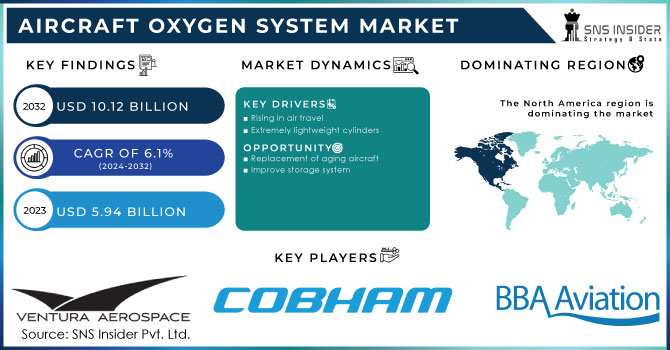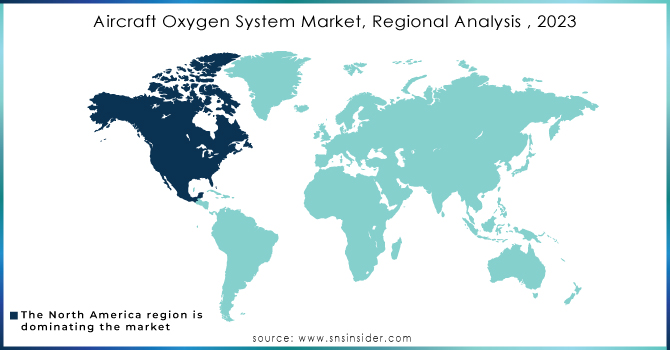Aircraft Oxygen System Market Report Scope & Overview:

To get more information on Aircraft Oxygen System Market - Request Free Sample Report
The Aircraft Oxygen System Market Size was valued at USD 5.94 billion in 2023 and is expected to reach USD 10.12 billion by 2032 with a growing CAGR of 6.1% over the forecast period 2024-2032.
The oxygen system in the aircraft provides oxygen to the passengers and crew of the aircraft when operating. These systems are used when cabinet air pressure decreases due to an aircraft operating more than 12,000 ft., Or in emergencies. The human body, like a highly aerobic organism, uses oxygen at the muscle levels in line with metabolic requirements. Any decrease in atmospheric pressure affects the amount of oxygen available to breathe. The airplane cabinet should be pressurized to double the pressure at high altitude to allow for human presence on the plane at high altitudes. Airline systems are designed to control and reduce oxygen levels as needed, or to create a pure air supply for staff or passengers. Gas use in air conditioning is a common occurrence in airplanes, however use varies depending on the type of aircraft. The air cylinders are properly adjusted to feed the system with a controller and a tube in the air system of a double-engine airplane, built into high performance. If each oxygen supply is required, the passenger component includes multiple respiratory channels through which all passengers can connect the pipe and mask. The aircraft used for transport have an expanded oxygen oxygen system built-in and serve as a backup compression cabin system.
MARKET DYNAMICS
KEY DRIVERS
-
Rising in air travel
-
Extremely lightweight cylinders
OPPORTUNITIES
-
Replacement of aging aircraft
-
Improve storage system
IMPACT OF COVID-19
Due to the outbreak of COVID-19, the operation of many industries has been suspended or they are working with fewer workers due to forced closures and restrictions imposed by governing bodies. The global market for military oxygen system is no different, and this feature is expected to have a significant impact on the industry's revenue growth. In addition, the high cost associated with the installation and maintenance of these devices is also a factor that could hamper the growth of market revenue for the air force system of military aircraft worldwide during this forecast period.
Material development has led manufacturers in the aerospace industry to introduce improved storage systems. In addition, their main problem is the need for comfort. Given the high altitude at which passenger planes operate, pilots have gradually been urged to use these devices in recent years. Advances in portable oxygen technology have helped to increase the market for aviation systems. The use of oxygen systems in airplanes requires extreme ingenuity. If the necessary safety precautions are not taken, there is a good chance that a fire may occur. In addition, there have been reports that air cylinders suddenly fail due to human error, especially flight attendants. All of this has led the aviation industry to become more cautious when it comes to the use of oxygen systems in aircraft.
By Mechanism, the market is divided into two Chemical Oxygen generators and Compressed Oxygen systems. With regard to the type of equipment, the chemical oxygen system is predicted to grow very rapidly during the forecast period. When the source is activated, a chemical system of oxygen composed of sodium chromate (NaClO3) and small amounts of other chemicals converts these molecules into oxygen. These machines are located above the passenger seat in the upper stowage bin. The FAA's mandate for the use of chemical oxygen systems on aircraft carrying more than 20 people is a major factor in the rapid growth. Based on the Type of System, the market is divided into Passenger Oxygen systems, as well as Crew Oxygen systems. At the time of speculation, the passenger oxygen system is expected to remain the largest component. The passenger oxygen systems market is driven by a higher number of passenger oxygen systems in the aircraft cabinet than by staff oxygen systems, and a higher rate of conversion.
KEY MARKET SEGMENTATION
By System
-
Passenger Oxygen System
-
Crew Oxygen System
By Component
-
Oxygen Storage
-
Oxygen Delivery
-
Oxygen Mask
By Mechanism
-
Chemical Oxygen Generator
-
Compressed Oxygen System
REGIONAL ANALYSIS
Latin America, Asia-Pacific, the Middle East and Africa, Europe, and North America form major market regions for aircraft systems. The global aviation oxygen system market is expected to see significant growth in regions such as North America and Europe. Increased air intake even for shorter routes may further enhance the need for oxygen in the aircraft. With the presence of the best market players in these regions, the market is likely to climb higher in the coming years. Asia Pacific is one of the fastest growing regions when it comes to air travel. According to IATA, China and India are likely to own about half of the world's passengers over the next two decades. Such increases are due to higher revenue, reduced flight costs, and better communications by air travel in the region.

Need any customization research on Aircraft Oxygen System Market - Enquiry Now
REGIONAL COVERAGE:
-
North America
-
USA
-
Canada
-
Mexico
-
-
Europe
-
Germany
-
UK
-
France
-
Italy
-
Spain
-
The Netherlands
-
Rest of Europe
-
-
Asia-Pacific
-
Japan
-
south Korea
-
China
-
India
-
Australia
-
Rest of Asia-Pacific
-
-
The Middle East & Africa
-
Israel
-
UAE
-
South Africa
-
Rest of Middle East & Africa
-
-
Latin America
-
Brazil
-
Argentina
-
Rest of Latin America
-
KEY PLAYERS
The Major Players are BASA Aviation, Ventura Aerospace, Cobham, Aeromedix, Precise Flight, Zodiac Aerospace, Air Liquide, Aviation Oxygen System, Technodinamika, B/E Aerospace, and other players
| Report Attributes | Details |
|---|---|
| Market Size in 2023 | US$ 5.94 Billion |
| Market Size by 2032 | US$ 10.12 Billion |
| CAGR | CAGR of 6.1% From 2024 to 2032 |
| Base Year | 2023 |
| Forecast Period | 2024-2032 |
| Historical Data | 2020-2022 |
| Report Scope & Coverage | Market Size, Segments Analysis, Competitive Landscape, Regional Analysis, DROC & SWOT Analysis, Forecast Outlook |
| Key Segments | • By System (Passenger Oxygen System, Crew Oxygen System) • By Component (Oxygen Storage, Oxygen Delivery, Oxygen Mask) • By Mechanism (Chemical Oxygen Generator, Compressed Oxygen System) |
| Regional Analysis/Coverage | North America (USA, Canada, Mexico), Europe (Germany, UK, France, Italy, Spain, Netherlands, Rest of Europe), Asia-Pacific (Japan, South Korea, China, India, Australia, Rest of Asia-Pacific), The Middle East & Africa (Israel, UAE, South Africa, Rest of Middle East & Africa), Latin America (Brazil, Argentina, Rest of Latin America) |
| Company Profiles | BASA Aviation, Ventura Aerospace, Cobham, Aeromedix, Precise Flight, Zodiac Aerospace, Air Liquide, Aviation Oxygen System, Technodinamika, B/E Aerospace, and other players. |
| DRIVERS | • Rising in air travel • Extremely lightweight cylinders |
| OPPORTUNITIES | • Replacement of aging aircraft • Improve storage system |

